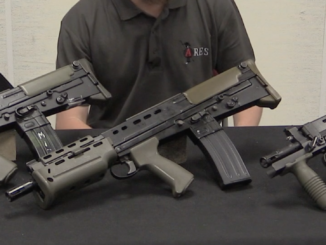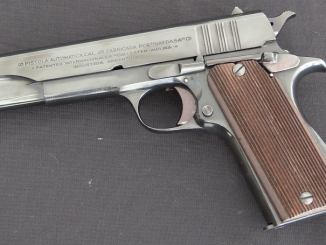In our continuing series on the development of the British Lee Enfield rifles, we are looking at the CLLE conversions today. In 1907 the British adopted a new universal short rifle (the SMLE) that used charger (aka stripper) clips. Previous models of the Lee in British service had to be loaded one round at a time by hand. In order to make use of the hundreds of thousands of “Long Lee” (and Metford) rifles already manufactured, the British instituted a program to update them with charger guides. The began in 1908 and ran to 1914, although the majority were done in 1909 and 1910. In addition to removing the dust cover and fitting the charger guide, the front sight, rear sight, magazine, and volley sights were all updated. The new sights were windage-adjustable on both front and rear, and calibrated for Mk VI ammunition (although many were later updated again and re-re-calibrated for Mk VII ammunition).
These CLLE rifles would serve as second-line rifles in World War One and even through the end of World War Two.




I was under the impression that a hand-fitted bolt cover that reciprocated with the bolt would keep mud out of the receiver and allow for charger loading if properly crafted. Of course, it appears to be a Japanese-only feature on one rifle family and an unfairly ridiculed feature for some stupid reason. I could be wrong.
Well, Ian did a video on WWI covers for Lebel and Gew98, but Lebel version was trialed and dropped and 98 version started production too late.
But in general it seems that before clip guides became necessary making a dust/mud cover for a bolt-action rifle was much easier. You can notice that the Lee’s dust cover is in fact closer-fitting than type 38’s. I also remember seeing video (either here or on the C&Rsenal0 about another bolt-action rifle with an excellent dust cover which was incompatible with the clip guide (I am not sure whether dust cover was ditched on the later iterations or it was one of those nations which were ok with single-loading at least until 1920 if not later).
There must be a union of “weapon stampers” in Britain that has complete control of the industry. Maybe unemployed engravers, trying to stay busy? They seem to have NEVER found a surface they can’t, and won’t, stamp.
Speaking of stamping, anyone who’s curious about the crown and “VR” on the receiver should know that stands for “Victoria Regina.” Victoria was still on the throne when that rifle emerged from the factory, though it was her last year. When she attained the throne in 1837, the standard British military rifle was the muzzle-loading percussion Enfield!
I’ve occasionally stamped my foot.
Someone dropped a heavy crate of nickel alloy ingot near my foot…
Um, no- in 1837 it was still flintlock Brown Bess for general issue. The rifle regiments started getting some percussion Brunswicks in late 1837, after V. R. was on the throne.
Photos exist of AMERICAN troops in England using these for training in London’s Hyde Park. Curiously, the slings are rope.
Are these CLLE rifles were safe to use with Mk. VII (WWI-era)cartridges?
I read a story where an Irish rebel used a Martini-Metford/Enfield during the 1916 uprising until the barrel burst after he fired over 100 Mk. VII rounds through it.
Any danger of that happening with a CLLE?